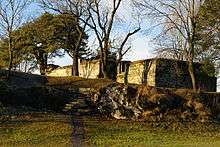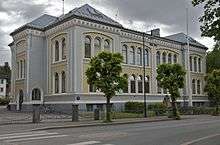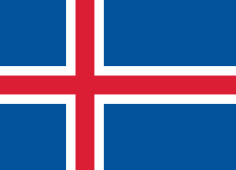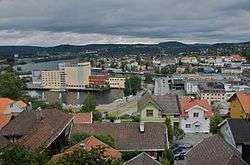Skien
| Skien kommune Skien | |||
|---|---|---|---|
| Municipality | |||
|
Skien City Centre | |||
| |||
 Skien within Telemark | |||
| Coordinates: 59°12′29″N 9°33′10″E / 59.20806°N 9.55278°ECoordinates: 59°12′29″N 9°33′10″E / 59.20806°N 9.55278°E | |||
| Country | Norway | ||
| County | Telemark | ||
| District | Grenland | ||
| Administrative centre | Skien | ||
| Government | |||
| • Mayor (2013) | Hedda Foss Five (AP) | ||
| Area | |||
| • Total | 779 km2 (301 sq mi) | ||
| • Land | 719 km2 (278 sq mi) | ||
| Area rank | 140 in Norway | ||
| Population (1 January 2013 census) | |||
| • Total | 53,952 | ||
| • Rank | 7 in Norway | ||
| • Density | 83,1/km2 (2,150/sq mi) | ||
| • Change (10 years) | 14.6 % | ||
| Time zone | CET (UTC+1) | ||
| • Summer (DST) | CEST (UTC+2) | ||
| ISO 3166 code | NO-0806 | ||
| Official language form | Neutral | ||
| Website |
www | ||
|
| |||

Skien [ˈʃeː'ən] (![]() listen)[1] is a city and municipality in Telemark county, Norway. It is part of the traditional region of Grenland. The administrative centre of the municipality is the city of Skien. Skien is also the administrative centre of Telemark county.
listen)[1] is a city and municipality in Telemark county, Norway. It is part of the traditional region of Grenland. The administrative centre of the municipality is the city of Skien. Skien is also the administrative centre of Telemark county.
Skien is one of Norway's oldest cities, with an urban history dating back to the Middle Ages, and received privileges as a market town in 1358. From the 15th century, the city was governed by a 12-member council. The modern municipality of Skien was established on 1 January 1838 (see formannskapsdistrikt). The rural municipalities of Gjerpen and Solum were merged into the municipality of Skien on 1 January 1964.
The conurbation of Porsgrunn/Skien is reckoned by Statistics Norway to be the seventh largest urban area in Norway, straddling an area of three municipalities: Skien municipality (about 62% of the population), Porsgrunn (30%), and Bamble (8%). This area is home to more than 100,000 people.
Skien was historically Norway's most important port town for shipping timber and one of Norway's leading commercial cities with extensive contact with neighbouring countries, particularly Denmark. The city was the birthplace of playwright Henrik Ibsen, and many of his famous dramas are set in places reminiscent of 19th-century Skien.
Demographics
In general the population of Skien is younger than the national average and the gap between rich and poor is wider. 60.4% Of Skien's population is ethnic Norwegian, an increase of 6% since 2002. 19.6% of Skien´s population are either first or second generation immigrants. The number is expected to rise to around 37% by 2030. African Norwegians make up the single largest ethnic minority. In 2013, 40% of Skien's primary school pupils were registered as having another first language than Norwegian.
General information
Name
The Old Norse form of the name was Skiða (from the word skiða which means "straight plank"), and the town is probably named after a brook (with a straight run) with this name.
Coat-of-arms
The coat-of-arms is derived from the oldest known seal of the city, dating back to 1609. The seal shows two skis and in the middle a cross, with a small star on the crosspoint. The skis are a semi-canting element (based on a misunderstanding of the meaning of the town's name) and the cross is a religious symbol. There have been several theories about the meaning of the cross, but its meaning is not clearly known. It has been suggested that it is a symbol for the main church in Skien, the Holy Cross church. The small star may be a symbol of St. Mary as the second medieval church of Skien was devoted to her. Besides the skis and cross, there are two meadow buttercups on each side.
In 1854, the arms were shown as two skis, but the cross was now made from ski poles, as another canting element. This remained so until the early half of the 20th century.
In the 1980s, the city officially adopted the current arms, which are identical to the oldest seal. The colours are the colours that have been used since the 19th century. The differences between the seal and the present arms are that in the arms the cross is placed on top of the skis and the star is changed from a four-pointed star to a six-pointed star, and that the cross is made of ski-poles.[2]
History
.jpg)
Until 1979, it was thought that Skien was founded in the 14th century. However, the archaeological discovery of a carving of the Skien animal has established that its founding preceded 1000 A.D. The city was then a meeting place for inland farmers and marine traders, and also a centre for trading whetstones from Eidsborg (inland Telemark). Gimsøy Abbey was founded in the 12th century. Skien was given formal commercial town rights by the Norwegian crown in 1358. Timber has historically been the principal export from Skien, and in the sixteenth century the city became the Kingdom's leading port for shipping timber. The oldest remaining building is Gjerpen church (built in approximately 1150).
From the 16th century, the city came to be dominated by a group of families known as patricians. In an 1882 letter to Georg Brandes, Henrik Ibsen mentions the families Paus, Plesner, von der Lippe, Cappelen and Blom as the most prominent patrician families when he grew up there.[3] The current town layout was fixed after the last town fire in 1886. In 1964, the rural municipalities Solum and Gjerpen were merged with Skien town, forming the Skien municipality.
Frogner Manor in Skien
Frogner Manor (Frogner Hovedgård) is a manor house on the outskirts of Skien. The manor house was built for shipowner and timber merchant Christopher Hansen Blom (died 1879) and his wife Marie Elisabeth (Cappelen) Blom (died 1834). The main building is influenced by Italian Renaissance architecture. The garden was laid out in English landscape style in the 1850s.[4]

Kapitelberget
The Church on Kapitelberget (Kirken på Kapitelberget) was a medieval church. Kapitelberget was a private chapel on Bratsberg farm dating to the early 1100s. It is not known when the church went out of use, but Bratsberg farm burned down in 1156. in 1576, Peder Claussøn Friis reviewed it as a ruin. The site was first excavated in 1901. In 1928, Gerhard Fischer undertook restoration and preservation. The work was completed in 1933. [5][6]
Transportation
Roads
The main road into Skien is from the E18 road and through Porsgrunn, on either road 36 or 354 that runs up along Porsgrunnselva on each side. Another common route used by most buses coming from Oslo is road 32, that goes through Siljan, Steinsholt, Lågendalen, Hvittingfoss and Hof. Road 32 enters the E18 in Hof. 564598-168
Water
Skien is the main terminus for the Telemark Canal. The "Norsjø-Skienskanalen" section of the canal, with one terminus at Skien and the other at Løveid, was built in 1854–1861. In Europe, canals were commonly built in the pre-railroad period to transport goods, timber, and passengers. The "Porsgrunn river" runs from the lock at Skien through Porsgrunn to the Frierfjord. Skien harbour is located at Vold havneterminal.
Railroads
Skien was connected to the Norwegian railway network (Vestfoldbanen) in 1882. In 1919, Bratsbergbanen opened between Skien and Notodden. Norges Statsbaner still operates regular train services on both railways.
Air
The local airport is Skien Airport, Geiteryggen and serves domestic flights to Bergen and Stavanger as well as flights to Trondheim by the airline Vildanden.
Culture and recreation

Ibsen and Telemark Museums
Skien was the birthplace of the author and playwright Henrik Ibsen, probably the most important writer to emerge from Norway. Many of Ibsen's plays are set in an unnamed provincial town that suggests Skien. The former Ibsen family homestead at Venstøp outside Skien was established as the Ibsen Museum in 1958. The Ibsen Museum has now been incorporated into the multi-site Telemark Museum, which includes several other historical sites.
Music and entertainment
Ibsenhuset is the local culture and conference center in Skien. It also houses concerts by international and national artists, opera, theatre and other cultural events. Skien kunstforening has a department in Ibsenhuset, and the local culture school and library are also located in the building. The venue is also home to the regional symphony orchestra, Grenland Symfoniorkester.
Teater Ibsen is the city theatre, and is still used for small productions.
Skien Church is the largest church in Telemark county, and is famous for its two twin towers and great organ.
In the summer of 2009 Elton John held a concert at the new Skagerak Arena, the soccer pitch for the local soccer team Odd Grenland. Next to Skagerak Arena is Stevneplassen, where car shows, concerts, flea markets and the annual "Handelsstevnet" – a trade fair with entertainment and a small amusement park – are held. The Handelsstevnet was closed down after the annual fair in 2011.
In Skotfoss, a small suburb of Skien further up the Telemark Canal, concerts are held at Løveid Sluser. There are plans to hold cultural events and concerts at Klosterøya (a downtown graffiti park).
Amusement parks
There are no local amusement parks in Skien. Lekeland was a small amusement park for children just outside the town, but it closed in 2008. Every year there is a traveling carnival with rides and merry-go-arounds for a week, in "Stevneplassen". Norway's biggest outside climbing park, Himalaya Park, is located in Skien.[7] There is an indoor waterpark in Skien Fritidspark.[8]
Media
The daily newspapers Varden and Telemarksavisa are published in Skien. The local television for Telemark, TVTelemark, is located in Skien.
Economy
Commerce and industry
The largest industries are ABB Asea Brown Boveri (engineering firm), Norske Skog Union (a paper mill which was closed down in the spring of 2006), and EFD Induction (induction heating and induction welding).
Other important places of work are the Telemark Hospital and the County Governor of Telemark. Agder Court of Appeal is located in Skien.
Because the E18 highway lies outside of the metropolitan area of Grenland, Skien has lost many important companies to the cities in Vestfold.
Shopping
Skien has three shopping malls:
- Handelsbyen Herkules (110 stores and services)
- Arkaden Skien Storsenter (47 stores and services)
- Lietorvet Senter (28 stores and services)
Sports
Arenas
|
Clubs
|
Notable residents
- Severin Løvenskiold (1777-1856), landowner, Prime Minister, Governor of Norway
- Peter Andreas Munch (1810-1863), historian
- Henrik Ibsen (1828-1906), playwright
- Brynild Anundsen (1841-1913), Norwegian-American editor and publisher
- Gunnar Knudsen (1848-1928), Prime Minister of Norway
- Hjalmar Johansen (1867-1913), polar explorer
- Aage Samuelsen (1915-1987), evangelist and composer
- Kari Lövaas (b. 1939), soprano
- Tor Åge Bringsværd (b. 1939), author
- Yngvar Numme (b. 1944), musician, entertainer
- Bjørn Tore Godal (b. 1945), former Minister of Foreign Affairs
- Iver Kleive (b. 1949), musician
- Jon Fredrik Baksaas (b. 1954), CEO of Telenor
- Audun Kleive (b.1961), musician
- Bugge Wesseltoft (b. 1964), musician
- Frode Johnsen (b. 1974), football player
- Tommy Svindal Larsen (b. 1974), football player
- Rune Almenning Jarstein (b. 1984), football player
International relations
Twin towns and sister cities
The following cities are twinned with Skien:
 Belozersk, Vologda Oblast, Russia
Belozersk, Vologda Oblast, Russia Loimaa, Varsinais-Suomi, Finland
Loimaa, Varsinais-Suomi, Finland Minot, North Dakota, United States
Minot, North Dakota, United States Mosfellsbær, Iceland
Mosfellsbær, Iceland Onești, Bacău County, Romania
Onești, Bacău County, Romania Sorrento, Campania, Italy
Sorrento, Campania, Italy Thisted, Region Nordjylland, Denmark
Thisted, Region Nordjylland, Denmark Uddevalla, Västra Götaland County, Sweden
Uddevalla, Västra Götaland County, Sweden
References
- ↑ Skien, snl.no
- ↑ Norske Kommunevåpen (1990). "Nye kommunevåbener i Norden". Retrieved 2009-01-18.
- ↑ Ibsen, Henrik (21 September 1882), "Letter to Georg Brandes", Henrik Ibsens skrifter, University of Oslo
- ↑ "Blom – slekt fra Skien". Store norske leksikon. Retrieved February 1, 2016.
- ↑ Wilhelm Swensen. "Kirken på Kapitelberget". Porsgrunn biblioteks. Retrieved September 1, 2016.
- ↑ Jon Gunnar Arntzen. "Bratsberg". Store norske leksikon. Retrieved September 1, 2016.
- ↑ "Himalaya Park". himalayapark.no. Retrieved 2009-02-06.
- ↑ "Badeland, Skien fritidspark". visitgrenland.no. Retrieved 2009-02-06.
External links
| Wikimedia Commons has media related to Skien. |
| Look up Skien in Wiktionary, the free dictionary. |
- Municipal fact sheet from Statistics Norway
 Telemark travel guide from Wikivoyage
Telemark travel guide from Wikivoyage Skien travel guide from Wikivoyage
Skien travel guide from Wikivoyage- Municipal website (in Norwegian)
- Municipal website (in Norwegian)
- Municipal website (in English)



.jpg)

